57 Huge Hippo Facts: Complete Guide to the Massive Hippopotamus
Hippos are huge, docile mammals. Or are they? In this post, you’ll learn 57 hippo facts about one of Africa’s most dangerous animals. You’ll learn about their size, habits, physical traits. And we also cover pink hippo milk and poop sprinklers. Plus tons of photos and videos.
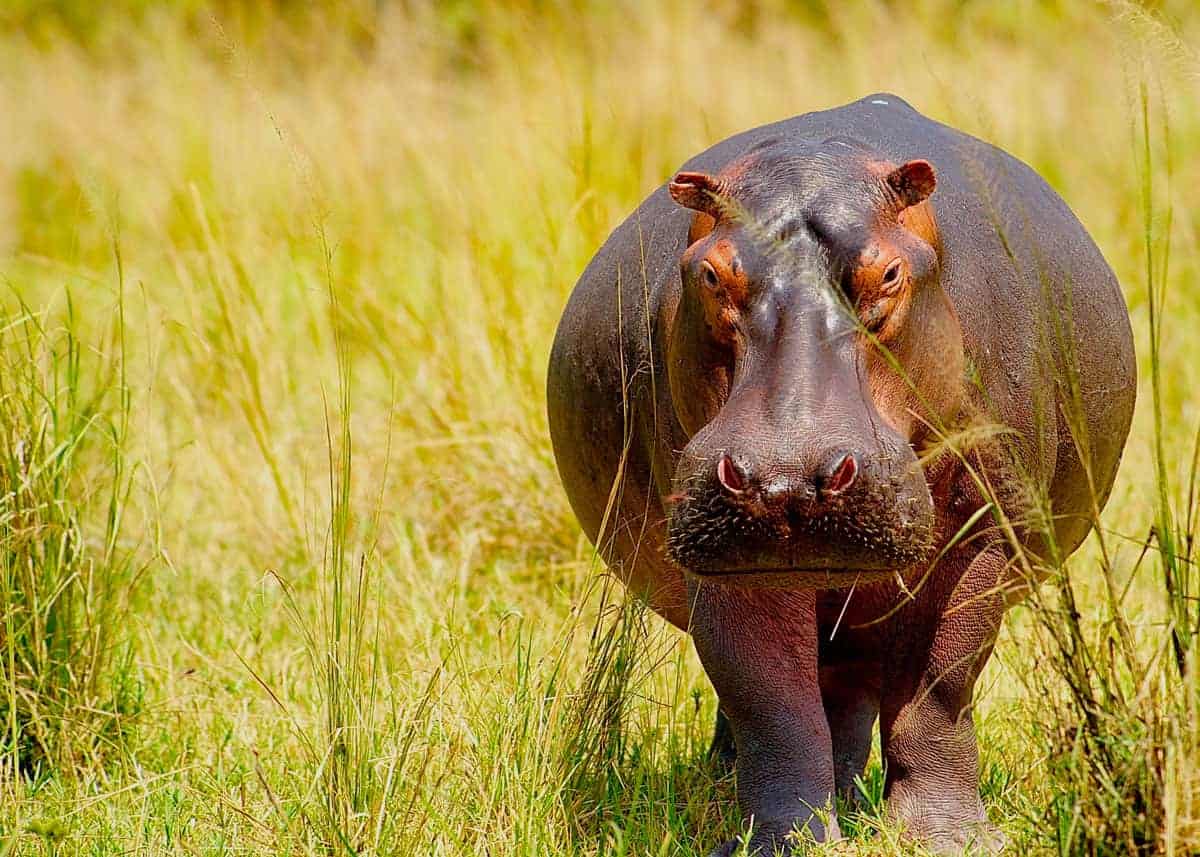
For your safety: we recommend a good pair of binoculars and a good safari-grade camera with a zoom lens. These will allow you to see and shoot hippos without risking a face-to-face encounter.
57 Huge Hippo Facts
Hippopotamuses may look like cute, comical giants, but they are among the world’s most dangerous animals. The more you learn about these semi-aquatic beasts, the more you will discover several surprising hippopotamus facts.
From where they live to why their mouths are so big, here are 57 hippo facts.
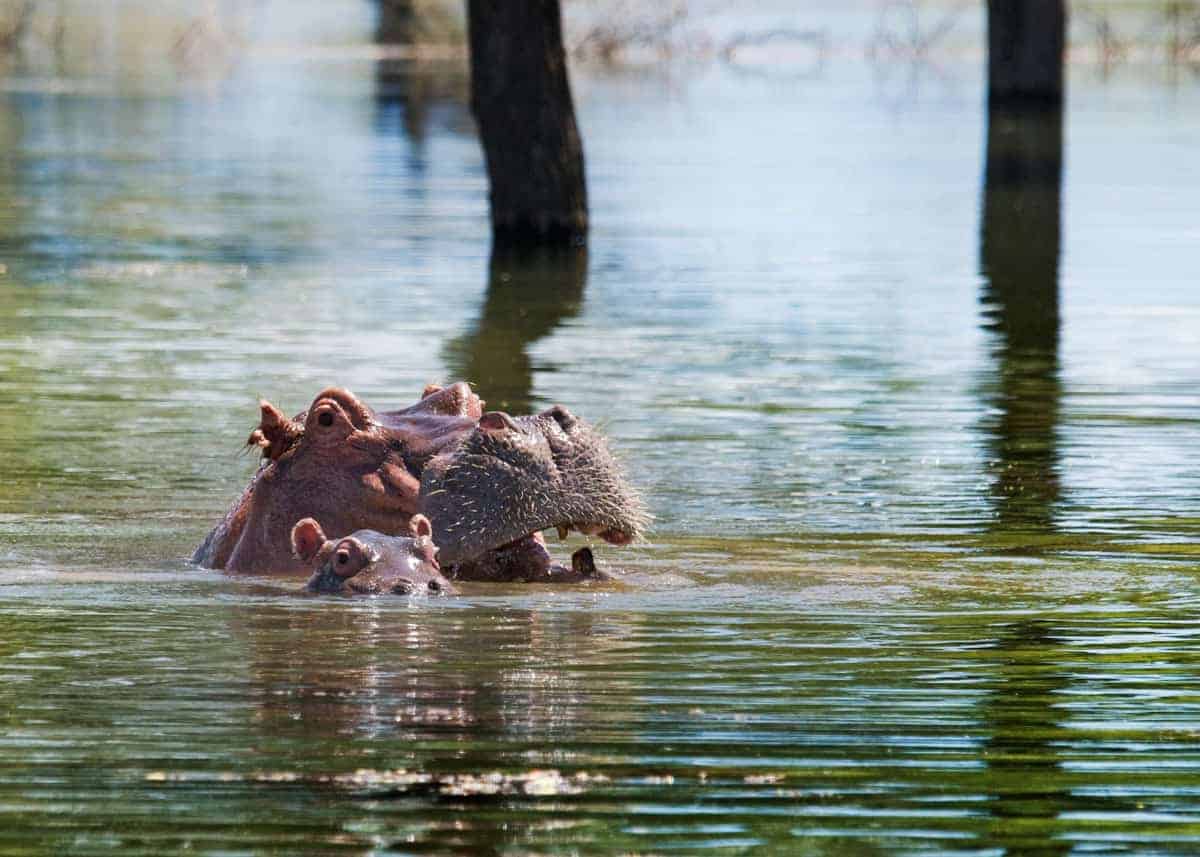
1. How many species of hippos are there?
While experts believe there were once five species of hippos, only two remain today: the pygmy hippo and the common hippo, with the latter being the focus of this article.
- Latin name: Hippopotamus amphibius
2. Where do common hippos live?
Common hippos live in sub-Saharan Africa in areas of abundant water, mud, and grass. They love the water and can spend up to 16 hours a day in it, keeping their skin cool. At sundown, they come out of the water and munch on grass.
Can you believe they eat up to 150 pounds (68 kg) a night?
3. How much does a hippopotamus weigh?
Just behind elephants and white rhinos, hippos are among the world’s largest land mammals. Some adult males (called bulls) can weigh up to nearly three tons, but the average range is between 3,300 and 7,050 pounds (1,500 and 3,200 kg).
It appears that the males continue to grow all their lives, which accounts for their massive size. Female adults, on the other hand, usually weigh a couple hundred pounds less than the males, and they stop growing around the age of 25 (even though they share the same lifespan as males).
At birth, hippo calves can weigh between 55 and 100 pounds (23 and 45.35 kg). They are born underwater but must paddle to the surface to take their first breath. Baby hippos nurse underwater by closing their nostrils and ears, but they also nurse on land as well.
4. How tall is a hippo?
A common hippo can grow up to a little over 5 feet (1.52 m) tall at the shoulder and between 10 and 16 feet (3 and 5 m)long. This means a hippo could take up a majority of your living room!
To put their size in an even better perspective, an adult hippo is about the size of your average car.
5. What does a hippo look like?
A hippo is a massive gray creature with a large, round barrel-shaped body and short pudgy legs that each end in four webbed toes.
The hippo’s head is large and elongated with the eyes, ears, and nostrils situated on the top part. This allows the hippo to keep its face above water while the rest of its body is submerged. The hippo is also known for its thick, hairless hide, huge gaping mouth, and ivory teeth.

6. Do hippos have teeth?
Of course, hippos have teeth. In fact, they have 36 teeth that include one canine, two incisors, three premolars, and three molars on each side of their jaws. Some hippos may have up to 40 teeth because they can retain their milk teeth for several years after reaching adulthood.
Here are a couple other hippopotamus facts about their teeth that you may find interesting:
- Hippo canine teeth continue to grow and can even reach up to 50 cm (1 ft 8 in) in length.
- A hippo will starve to death if its molars wear down too much to break down food.
- Hippopotamus teeth sharpen themselves – by constant grinding against the shorter upper canines.
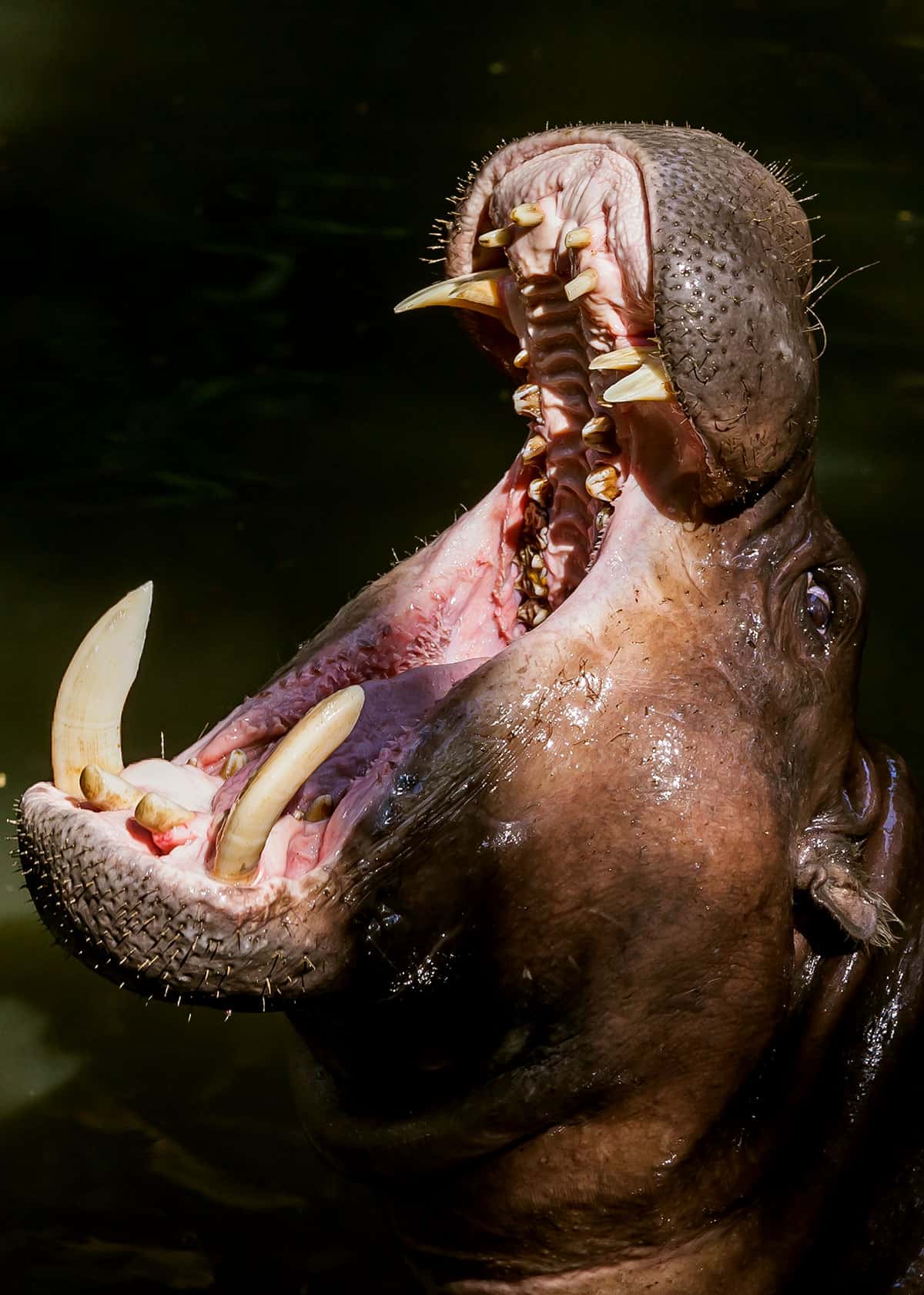
How’s your Swahili? Check out our guide to 100+ animal names in Swahili.
7. Do hippopotamus have tusks?
Sort of. Their canine teeth are somewhat tusk-like. Hippos use these enlarged teeth for fighting. Tusk clashing consists of males locking teeth and wrestling. A tusk clash is somewhat similar to a pair of deer locking antlers. Except these guys can weigh up to 3 tons each.

Their tusks are twice as long in males, an example of sexual dimorphism.
Watch two hippo bulls clash in this video:
8. Do hippos have ivory?
Yes, hippos do contain ivory. Their canine teeth, which can grow up to 50 cm (1 ft 8 in) long, are ivory.
The ivory from hippo tusks is softer than ivory from elephant tusks.
In addition to these hippo facts, did you know that George Washington (the first US president) wore false teeth made from hippopotamus ivory?
9. Where do common hippos live in Africa?
Common hippos live in the eastern central region of Africa and below the Sahara Desert.
Some of the many African countries where hippos can be found include Uganda, Kenya, Sudan, Rwanda, Botswana, Senegal, Gambia, Chad, Zambia, Togo, Tanzania, Mozambique, Ghana, the Republic of Congo, and South Africa.
10. What is the habitat of the common hippo?
The common hippo lives in habitats of water and grass such as lakes, rivers, and mangrove swamps.
A hippo needs plenty of water to accommodate its large size, but it usually doesn’t like water that is too deep or too shallow. As long as the water is deep enough to reach its head, life is good for the hippo.
11. Where can I see hippos in Uganda? 4 Places
The best places to see hippos in Uganda are these four national parks:
- Queen Elizabeth National Park: Here, you can take a boat ride along the Kazinga Channel to see hundreds of hippos. This area has the highest concentration of hippos in Uganda.
- Murchison Falls National Park: A boat safari on the Nile River, or along Lake Albert, presents you with great opportunities to photograph hippos as they bask in the mud while yawning or scuffling with one another.
- Lake Mburo National Park: You can see hippos on a boat ride or game drive along any of the five lakes within this national park.
- Semliki Wildlife Reserve: The hippo population may not be as plentiful here, but if you are already visiting this reserve, you have a good chance of seeing hippos on the Semliki River.
Watch this traveler video of a boat ride in Queen Elizabeth National Park, Uganda. You’ll see many Ugandan animals, including hippos, elephants, cape buffalo, marabou stork, and nile crocodiles.
12. Why is a hippo so dangerous?
Hippos just may be the most dangerous land mammals in the world. They are highly territorial and can attack anything that wanders into their territory, whether that be human or animal.
They are enormous creatures that can crush you in a heartbeat or drown you by overturning your boat. They have huge mouths with super sharp teeth and tusks and have been known to take down large animals such as buffalo, impala, and kudu.
Despite their size and short legs, they are agile and can run really fast.
13. Are hippos aggressive?
Hippos are highly aggressive and unpredictable, especially when their calves are present, which is why they are considered so dangerous. Because of their sluggish appearance, many people may see hippos as gentle giants, but they are far from that. They can charge without a moment’s hesitation and do serious damage.
If you see a hippo yawning, you may think it’s cute, but in reality, a hippo yawn is a warning signal. If you ever hear a hippo making a deep laughing sound, it is not a funny situation because this means the hippo is sounding off a warning.
Hippos also exhibit some pretty gross methods of marking their territory such as urinating backward or spinning their tails while excreting dung to scatter it over a wide area.

14. Are hippos Africa’s most dangerous animal?
Aside from mosquitos and the tsetse fly, hippopotamuses are the most deadly animal in Africa.
And hippos are the most dangerous large mammal worldwide, killing an estimated 500 people per year in Africa.
15. Will a hippo eat a human?
Even though humans are killed more by hippos than any other animal in Africa, hippos are not likely to eat a human because they are herbivores. Their digestive systems are not suited for digesting meat.
However, there have been a few hippos that were observed eating buffalo, wildebeest, and impala as well as another hippo eating the carcass of its own species. Experts believe hippos that eat meat are nutrient-deficient, sick or distressed.
16. Can a hippo kill a lion?
A hippo could kill a single lion in a one-on-one clash because its huge mouth and powerful bite can easily crush the lion’s head and bones. However, a hippo would have a hard time defending itself against a pack of lions.
17. What eats a hippopotamus?
A pack of lions may work together to bring an adult hippo down, but they would have to be really hungry to make such a dangerous attempt.
However, spotted hyenas, lions, and crocodiles are known to eat young hippos if they can steal them without getting mauled by the mother hippos.
Over the centuries, native African tribes have traditionally eaten hippos, but few animals are ever willing to take on a hippopotamus for supper.
18. What do hippos eat at the zoo?
At many zoos, such as the San Diego Zoo, hippos are fed Bermuda hay and alfalfa, lettuce, mixed vegetables, herbivore pellets, and occasionally, melons.
19. What can kill a hippo?
A human with a gun can kill a hippo, and a pack of lions can take down a hippo with hard teamwork. Some people say a rhino can kill a hippo, but there is much debate about that.
21. How strong is a hippo bite?
Another of several astonishing hippo facts is that these beasts can chomp down with a brutal force of about 2,000 pounds per square inch. To understand how powerful of a bite that truly is, compare it to the human bite force of 200 pounds per square inch.
22. Can a hippo kill a rhino?
There is an ongoing debate about who would win in a rhino-versus-hippo battle. Some people say the rhino would triumph because of its larger size, vicious horn, and faster speed.
Others claim the hippo has more advantages that include its enormous mouth that can dole out lethal damage. The hippo can see better since rhinos have poor eyesight, and a bull hippo has much more experience fighting from defending his harem opposed the rhino who lives a solitary life.
A rhino could stand a better chance of killing a hippo away from water because if a hippo can pull the rhino into its territory, it could be history for the rhino.
Perhaps it is more accurate to say that rhinos and hippos are capable of killing each other.
23. Why do male hippos attack baby hippos?
Although it is not common, bull hippos do attack and kill hippo calves. Experts aren’t really sure why, but they believe it happens when herds become overpopulated, their habitat begins to dwindle, or when food is scarce.
24. What are hippos good for?
Hippos play an important role in the African ecosystem.
- On land, their heavyweight stirs up the soil and clears vegetation around the wetlands.
- Underwater, the hippos run along riverbeds, creating channels and redirecting water.
By changing up the ecosystem like this, hippos construct shelter and habitats for smaller creatures.
Hippos eat on land and poop in the water, providing nutrients to aquatic life. For example, the hippo dung fertilizes water plants, and some fish directly eat the hippo dung while other fish eat insects that have previously fed off it.
25. Are hippos endangered?
No, hippos are not endangered, but they are declared vulnerable to extinction by the International Union for Conservation of Nature (IUCN). Want to know why? Keep reading for more hippopotamus facts and we’ll tell you the reasons.
26. Why are hippos going extinct?
Habitat loss and unregulated poaching and hunting are the top reasons why hippo numbers are declining.
Hippos are often killed because they pose such a dangerous threat to people competing for fresh water. They are also hunted and killed for their meat and ivory tusks and teeth which sell for big bucks on the black market.
27. How large is the hippo population?
Once upon a time, hippos roamed as far as Asia and Europe. Today, their overall population is limited to Africa, with their numbers estimated between 125,000 and 148,000.
The Democratic Republic of the Congo once boasted the largest population of hippos until the country’s Second Congo War wiped out tens of thousands during the mid-1970s. Currently, the Africa countries of Zambia and Tanzania are home to the largest hippo populations.
28. What is a group of hippos called?
A group of hippos is called by many different terms by various people. They include herds, schools, pods, dales, and bloats.
You could say that hippos love hanging out with their bloats. It’s also interesting that their groups are called schools because adults actually do teach their young many important things such how to defend themselves.
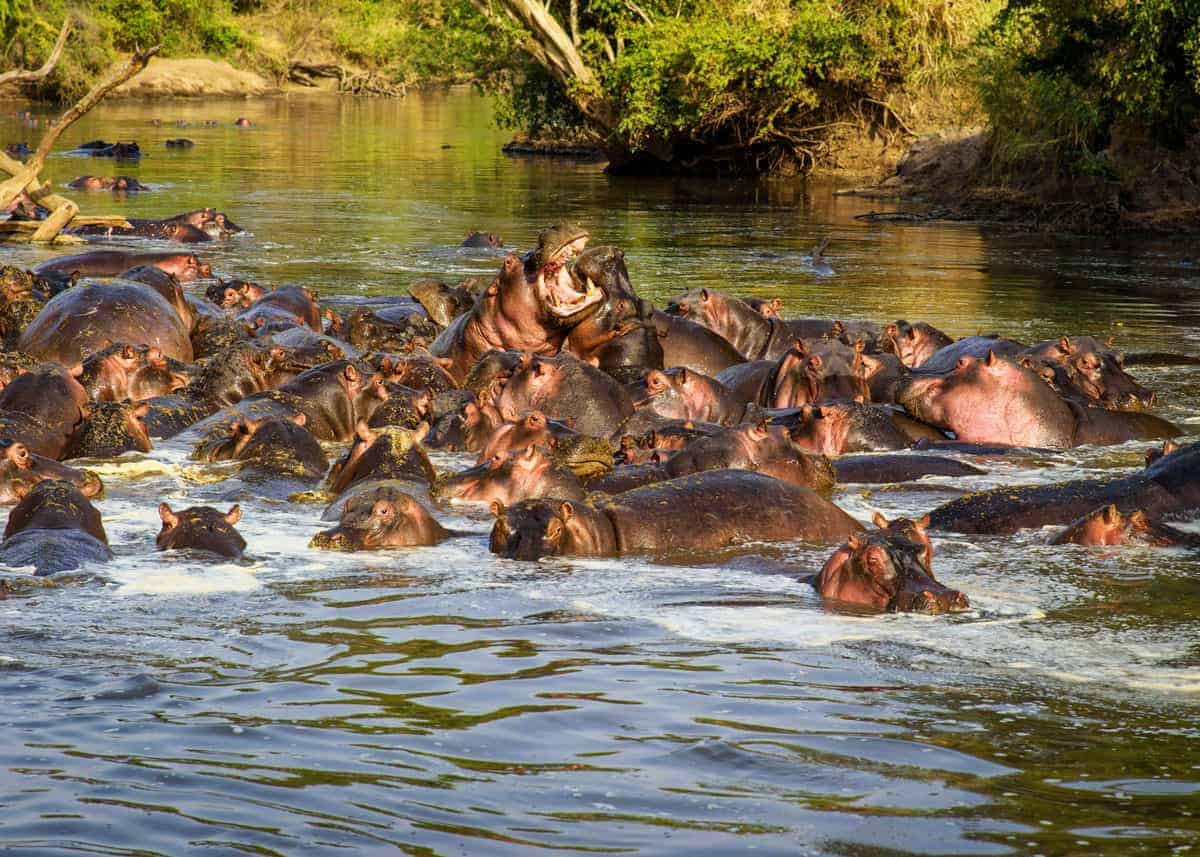
29. How large is a herd of hippos?
Hippos are social and usually hang out together in groups of 10 to 30 individuals, but some groups may include up to 200 members.
No matter how small or large a group, all hippo herds are led by a single, dominant bull. Many of these herds contain females, but bachelor hippos are allowed inside the community as long as they know to respect the bull hippo and not flirt with any of the females.
30. What animal can kill a crocodile?
Most animals won’t attempt to tango with a crocodile, but hippos have been known to kill them if their space is invaded.
Juvenile crocodiles sometimes fall victim to carnivores such as leopards, jaguars, otters, and pythons.
31. Why are crocodiles afraid of hippos?
Simply put, crocodiles are afraid of hippos because they can break a crocodile’s back with one single chomp. As if that’s not enough reason to fear, hippos live in large groups, and no crocodile is going to risk being mobbed.
If a hungry crocodile dares to go after a young, less dangerous hippo, the calf’s mother and all her sisters will come after the crocodile.
32. How fast can a hippopotamus swim?
Would you believe a hippopotamus cannot swim? You would think that an animal that spends a majority of its time in the water could swim, but hippos cannot.
However, they can move underwater at a speed of 15 mph (8 km/h). So, you won’t be able to outswim them!
33. How does a hippo swim so fast?
Hippos can’t swim. And not only can adult hippos not swim, but they aren’t even buoyant. That’s probably one of the most surprising hippopotamus facts of all. (However, calves are buoyant).
Hippos sink to the bottom of the water and then move by walking, trotting, jogging or running. When they are ready to return to the surface, they kick their hind legs to push off from the bottom and propel themselves upward.
34. How long can a hippo hold it’s breath underwater?
Adult hippos can stay underwater for up to five minutes at a time. They need to resurface every 3 to 5 minutes to breathe. (Baby hippos need to breathe every 2 to 3 minutes.)
Here are some more amazing hippo facts for you: Surfacing and breathing are automatic for hippos. They can even do it in their sleep without even needing to wake up.
35. Can you eat a hippopotamus? Is it legal?
People do eat hippo meat even though the sale of it is illegal. I am not sure what hippo meat tastes like, but I have heard it tastes bland. The American hunter and author, Peter Hathaway Capstick, describes it like this:
“It is my personal opinion that hippo meat is one of the finest of game foods … The taste is mild, less than lamb and more than beef, slightly more marbled than usual venison. It tastes exactly like, well, hippo.”
36. Do hippos eat fish?
Even though hippos live in the water with fish, they don’t eat fish. Hippos are herbivores, eating grass and occasionally some vegetables and fruits.
37. Do hippos eat watermelons?
Hippos love eating watermelons. In zoos, hippos are sometimes given whole watermelons, and they devour them, crushing them with their powerful mouths.
38. How many hours do hippos sleep?
It’s not known exactly how many hours hippos sleep per day. It is believed that they rest for short periods of time. Because they are up most of the night foraging for food, they spend a majority of the daytime in the water which is when they sleep.
If they are in deep water, they will resurface whenever they need to breathe without waking. If they are in shallow water, they will rest with their nostrils protruding just above the surface.
39. Do hippos have hair?
Hippos are almost completely hairless except for a few whiskers around their mouths and a tuft of hair on their tails. To make up for their lack of hair, their hides are exceptionally thick.
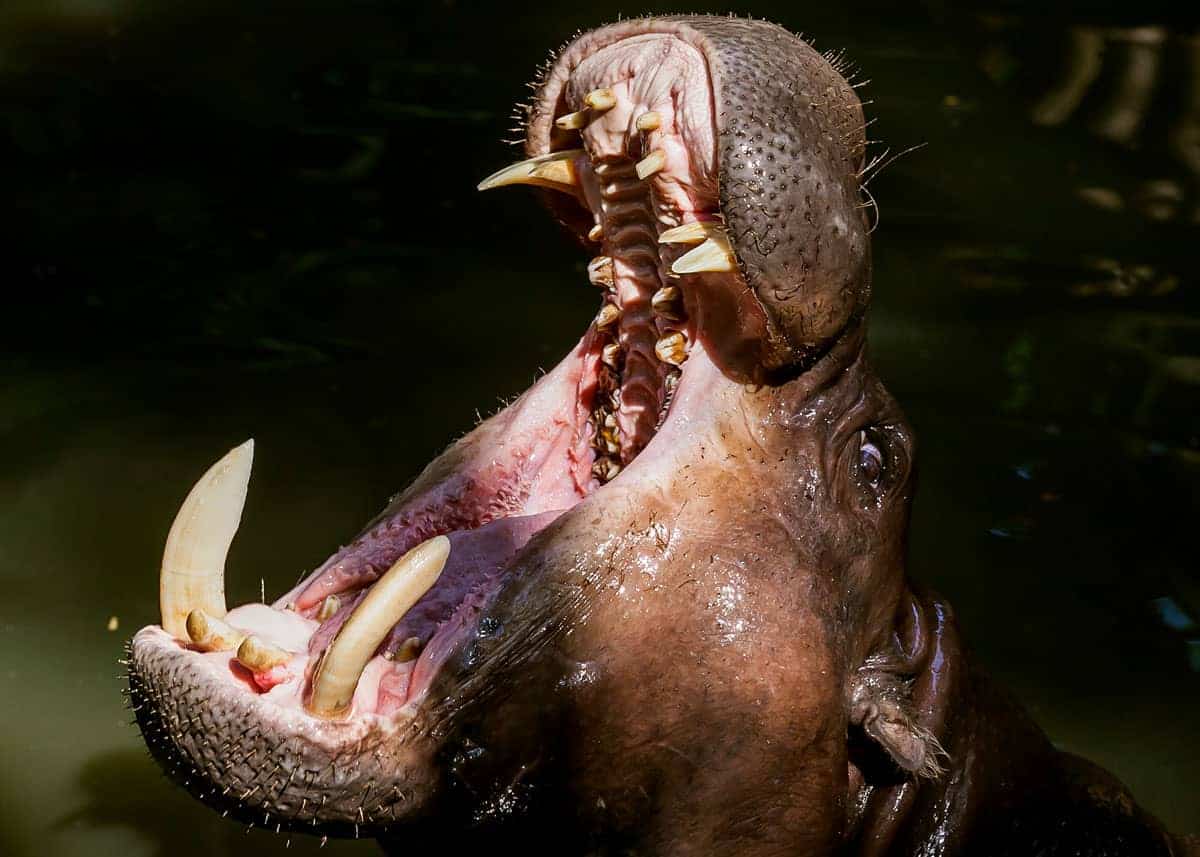
40. What is hippo “blood sweat”?
One of the most interesting hippo facts is that this animal secretes a red, oily substance that many have described as “blood sweat.”
Neither blood nor sweat, this secretion is a natural sunscreen that protects the hippo’s naked skin from the harsh African sun. Blood sweat is made up of two secretions: one red (hipposudoric acid) and one orange (norhipposudoric acid).
And it serves two purposes.
These highly acidic compounds inhibit bacteria (reducing disease) and absorb ultraviolet light (helping prevent sunburn and sun damage).
41. Do hippos drown?
Among the more interesting hippo facts is that hippos don’t drown because they close their ears and nostrils while underwater.
Hippos have a natural built-in reflex that causes them to reach for the surface to breathe.
They also have a membrane that closes over their eyes underwater. This 3rd eyelid is known as a nictitating membrane. And it’s something that hippos have in common with camels.
42. Do hippos roar?
Yes, hippos do roar. They also grunt, groan, and wheeze loudly.
43. Can you outrun a hippo?
Hippos may look lazy and sluggish, but don’t be deceived. They just want you to think that! On land, they can outrun a human.
They have been timed running between 19 and 25 mph (30 and 40 km/h). However, they can only keep up these high speeds for a few hundred meters.
44. Do hippos make noise?
Hippos make a great deal of noise. They are one of the loudest animal species in Africa. According to the San Diego Zoo, their vocalizations have been measured at 115 decibels. Do you know what it sounds like to stand about 15 feet away from a speaker at a rock concert? That’s how loud hippos are!
They grunt, grumble, bellow, roar, honk, humph, and wheeze loudly. They also make a deep, scary laughing sound that is really a warning signal.
Learn more about the sounds that a hippo makes.
45. Why do hippos have big mouths?
Hippos have big mouths to eat the whopping amount of food they need for their big bodies.
Another reason is that hippo cows love big bull mouths. The way they look at it is, the bigger the mouth, the better husband and father. Of course, hippos also use their big mouths as a defense against anything that invades their territory or threatens their calves.
46. How wide can a hippo open its mouth?
Most adult hippos can open their mouths at a 150-degree angle. For some bull hippos, it’s 180 degrees.
47. How do hippos give birth?
Hippos give birth underwater where they are the safest, but it’s usually in shallow water.
Here are some newborn hippopotamus facts:
- They can only hold their breath for about 40 seconds at a time.
- They stay in the water with their mother for the first several days until they gain strength.
- They nurse their mothers underwater and on land.
- They rest on their mother’s backs when the water is too deep for them.
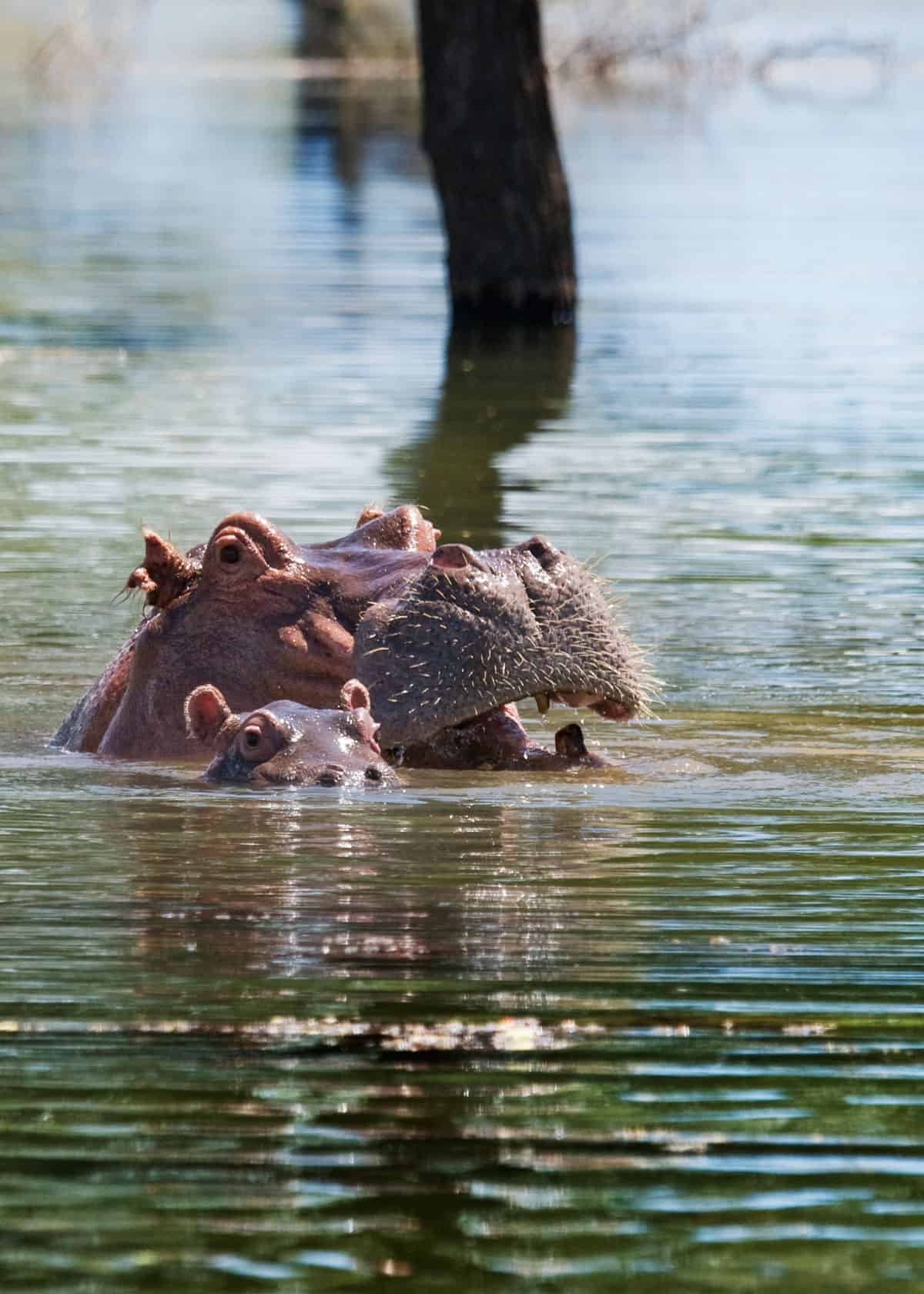
48. How many babies can a hippo have?
Most hippos only have one baby at a time. Twins are rare.
49. How often do hippos give birth?
An adult female hippo gives birth approximately once every two years.
50. How long does the hippo calf stay with its mother?
A hippo calf will nurse its mother until it’s about 18 months old.
After it is weaned, it will continue to stay nearby its mother for up to seven or eight years until it is fully grown.
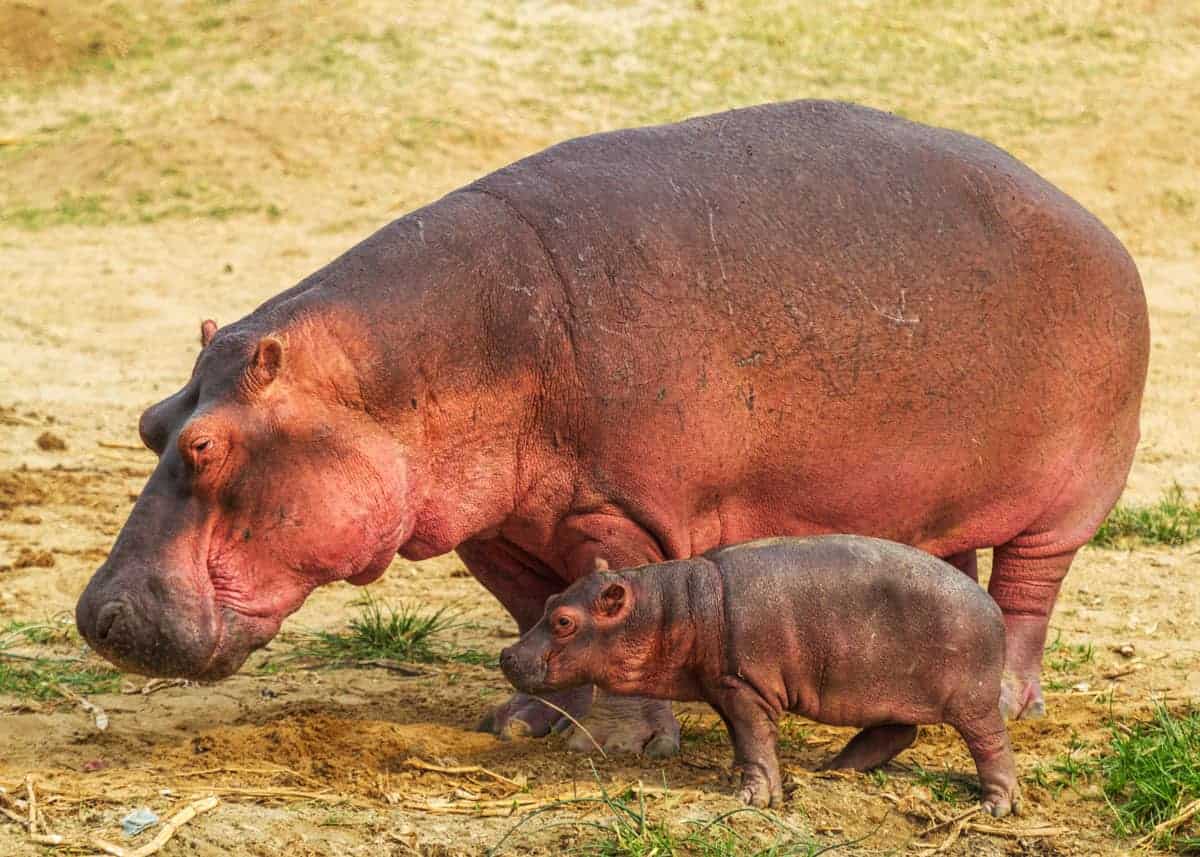
51. What is a female hippo called?
A female hippo is called a cow.
52. How long does a hippo stay pregnant?
The gestation period for a female hippo is eight months.
53. What age do hippos have babies?
Female hippos can have babies after they reach sexual maturity which is around five to six years of age.
54. How long can a hippo live?
The typical lifespan for a hippo is between 35 and 50 years.
55. What are the largest land mammals?
Hippopotamuses are the 3rd largest land mammal, after elephants and rhinos.
56. Is hippo milk really pink?
This commonly stated “fact” is actually a debunked legend. Even National Geographic got this wrong back in 2013, posting this on Facebook: “Friday Fact: A hippo’s milk is bright pink”. Whoops!
In theory, when the hipposudoric acid (red) mixes with the milk (white), it produces a pink solution. But there is actually no evidence to suggest that this ever happens.
57. Why do hippos become poop sprinklers?
There are countless videos of hippos spraying poop everywhere by mixing their runny poo with a rotating tail action. This is real and it appears to be a male dominance thing – where they are both impressing females and marking their territory.
Entertaining, but be sure to keep your distance.
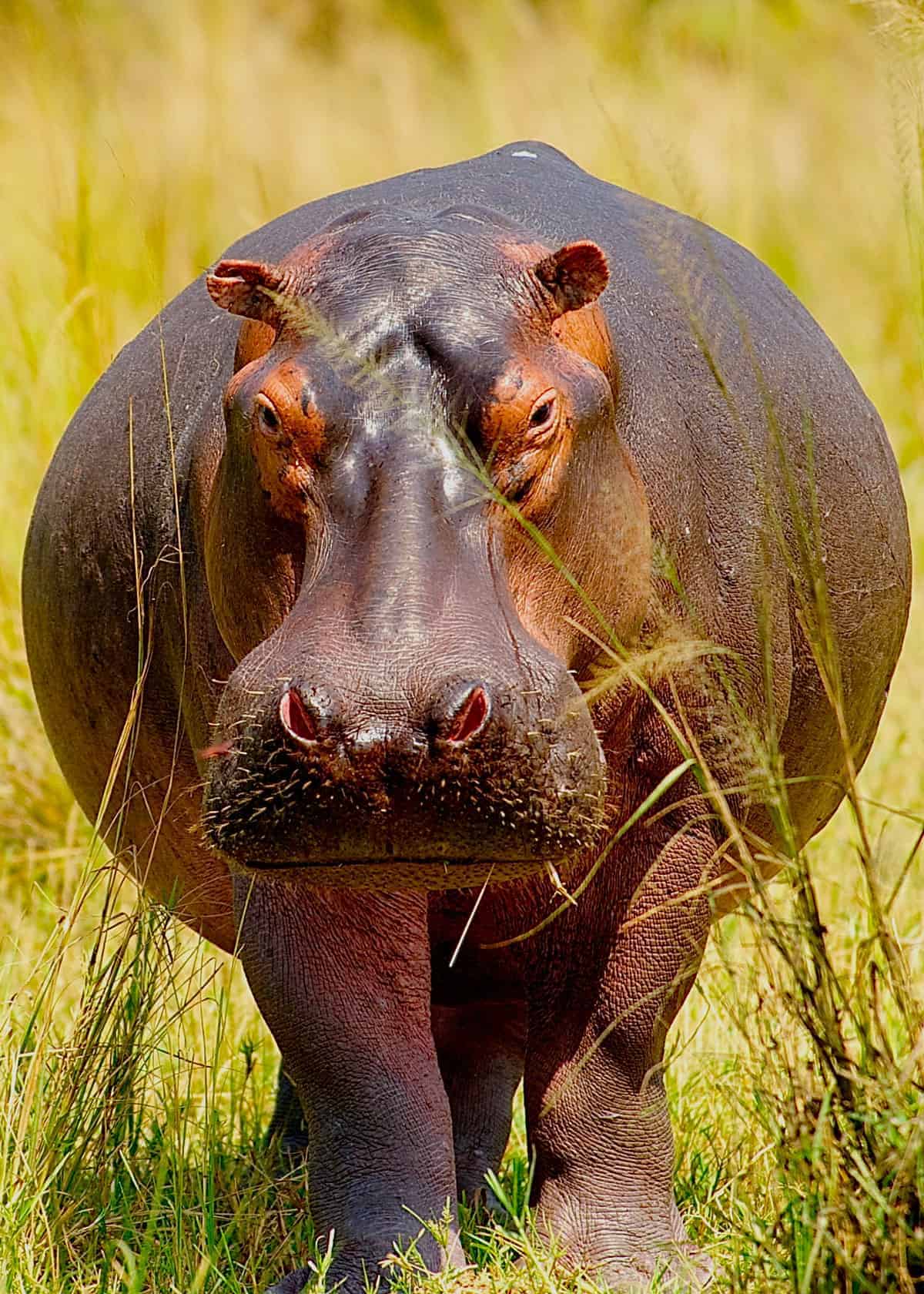
More reading: How fast can a crocodile run?
We hope these hippopotamus facts have helped you learn more about one of Africa’s most amazing creatures.
Now all you need to do is plan a Ugandan safari to see these animals in person. Just remember to keep a safe distance from them!






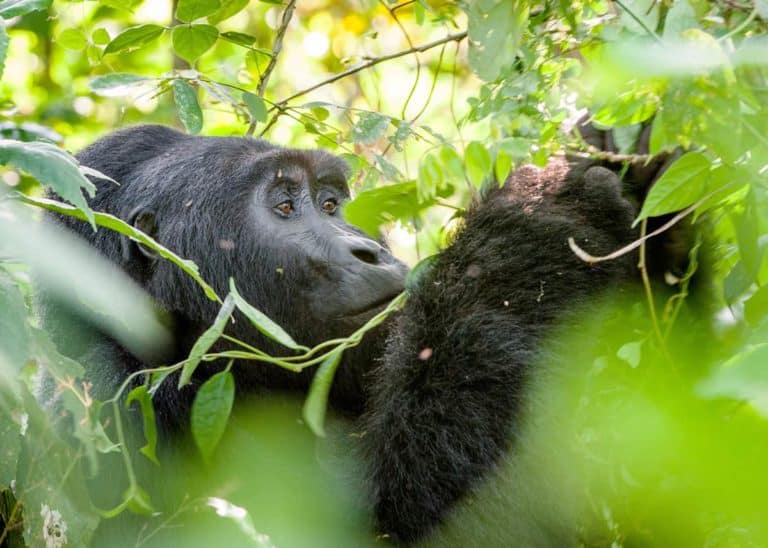
Hippos can swim and swim very fast , how can you put up something that you obviously don’t know much about ?
Sorry for the confusion. According to the San Diego Zoo:
I hope this clears things up!
ooo so cool i love hippos wowie